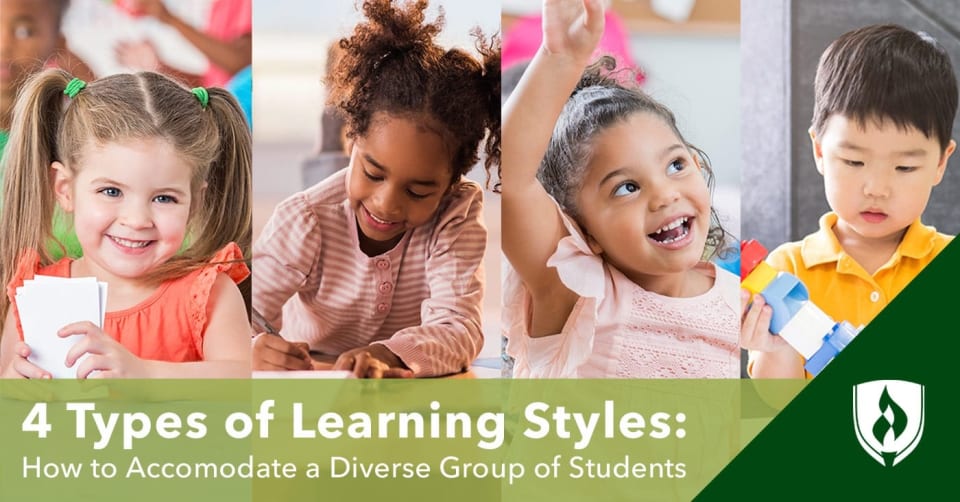How To Accommodate All Learning Styles

We all experience the world in unique means, and with that comes variation in the ways we learn best. Understanding these different types of learning styles can drastically bear on the way teachers handle their students, set up upward grouping projects and adapt private learning. Without understanding and acknowledging these unlike ways of learning, teachers might finish up with a scattering of students lagging backside their classmates—in role because their unique learning style hasn't been activated.
Role of your responsibleness as an educator is to suit your lessons to the unique group of students y'all are working with at any given time. The best teachers can cater to each pupil'due south strengths, ensuring they are truly grasping the information.
So how do you meet the needs of dissimilar types of learners in your course? Join united states as we outline the iv types of learning styles and how teachers tin practically apply this information in their classrooms.
Ways of learning: A closer look at 4 learning styles
Learning styles and preferences accept on a diversity of forms—and not all people fit neatly into ane category. But mostly speaking, these are the nearly common types of learners:
1. Visual learners
How to recognize visual learners in your form: Someone with a preference for visual learning is partial to seeing and observing things, including pictures, diagrams, written directions and more. This is besides referred to as the "spatial" learning manner. Students who learn through sight empathize data improve when it'south presented in a visual style. These are your doodling students, your list makers and your students who have notes.
How to cater to visual learners: The whiteboard or smartboard is your best friend when teaching these types of learners. Requite students opportunities to draw pictures and diagrams on the board, or inquire students to putter examples based on the topic they're learning. Teachers catering to visual learners should regularly make handouts and use presentations. Visual learners may also need more time to procedure textile, equally they find the visual cues before them. So be sure to give students a little time and space to absorb the information.
two. Auditory learners
How to recognize auditory learners in your course: Auditory learners tend to learn better when the subject matter is reinforced by sound. These students would much rather heed to a lecture than read written notes, and they often apply their own voices to reinforce new concepts and ideas. These types of learners prefer reading out loud to themselves. They aren't afraid to speak up in class and are great at verbally explaining things. Additionally, they may be slower at reading and may often repeat things a teacher tells them.
How to cater to auditory learners: Since these students generally find it hard to stay repose for long periods of time, become your auditory learners involved in the lecture by asking them to repeat new concepts back to you. Enquire questions and let them answer. Invoke group discussions so your auditory and verbal processors tin can properly take in and sympathise the information they're being presented with. Watching videos and using music or audiotapes are also helpful means of learning for this group.
3. Kinesthetic learners
How to recognize kinesthetic learners in your class: Kinesthetic learners, sometimes chosen tactile learners, learn through experiencing or doing things. They like to get involved by acting out events or using their easily to touch and handle in social club to understand concepts. These types of learners might struggle to sit nonetheless and oftentimes excel at sports or like to dance. They may demand to accept more frequent breaks when studying.
How to cater to kinesthetic learners: The best way teachers tin can help these students acquire is by getting them moving. Instruct students to act out a certain scene from a book or a lesson you lot're teaching. Also try encouraging these students by incorporating movement into lessons: pacing to help memorize, learning games that involve moving around the classroom or having students write on the whiteboard as part of an activeness.
Once kinesthetic learners can physically sense what they're studying, abstract ideas and difficult concepts become easier to understand.
4. Reading/writing learners
How to recognize reading/writing learners in your grade:According to the VARK Modalities theory developed by Fleming and Mills in 1992, reading/writing learners prefer to acquire through written words. While there is some overlap with visual learning, these types of learners are drawn to expression through writing, reading manufactures or books, writing in diaries, looking upwardly words in the dictionary and searching the internet for but nigh everything.
How to cater to reading/writing learners:Of the iv learning styles, this is probably the easiest to cater to since much of the traditional educational system tends to center on writing essays, doing research and reading books. Be mindful most allowing enough of time for these students to absorb information through the written word, and give them opportunities to get their ideas out on paper as well.
Embrace all types of learning
Understanding these dissimilar learning styles doesn't finish in the classroom. By equipping students with tools in their early years, teachers are empowering them for their futures. Pinpointing how a kid learns all-time can dramatically bear upon their ability to connect with the topics you're educational activity, as well as how they participate with the rest of the class.
Now that you lot take some tactics in your back pocket to accommodate different ways of learning, you may be curious near classroom management strategies. Learn more than in our article, "Proven Classroom Management Tips for Preschool Teachers ."
EDITOR'S Notation: This article was originally published in 2018. It has since been updated to include information relevant to 2020.
Source: https://www.rasmussen.edu/degrees/education/blog/types-of-learning-styles/
Posted by: perrybeephe1978.blogspot.com



0 Response to "How To Accommodate All Learning Styles"
Post a Comment